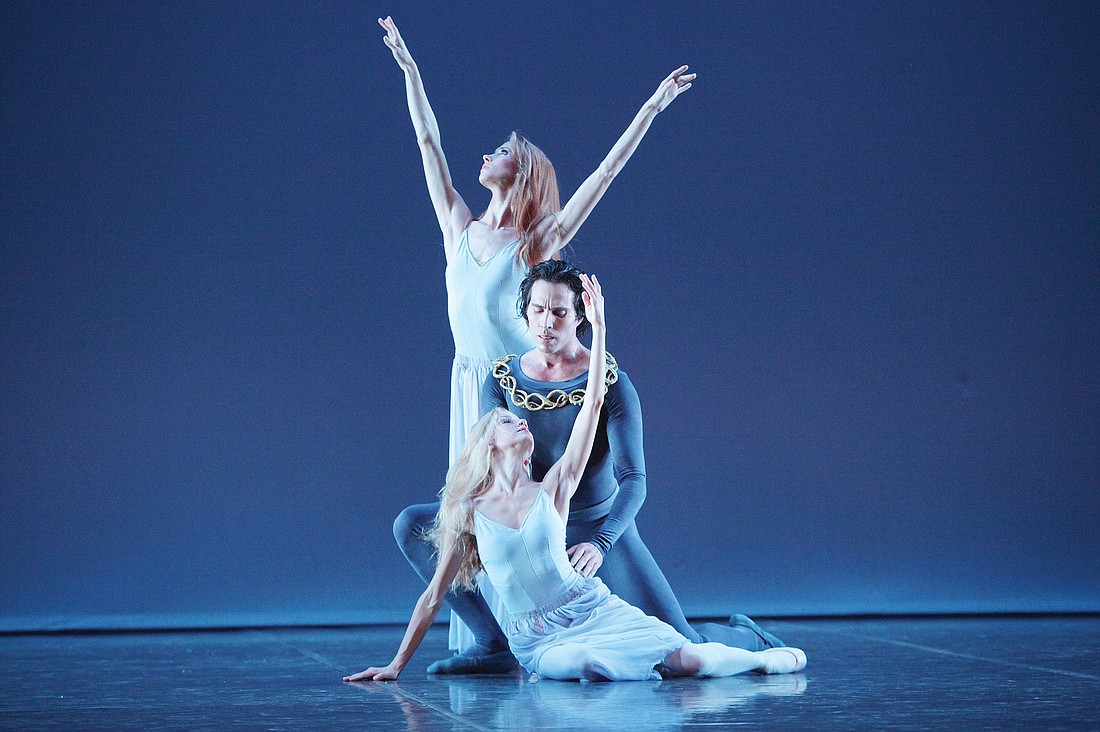- April 19, 2024
-
-
Loading

Loading

The Sarasota Ballet’s most recent production of George Balanchine’s “Serenade,” Dominic Walsh’s “Bello” and Twyla Tharp’s “Nine Sinatra Songs” was truly an exceptional evening. The company of dancers performed each piece with utmost dexterity and wonderful stage presence.
Balanchine’s “Serenade,” set to music by Pyotr Ilyich Tchaikovsky, is one of his all-time classic ballets, which he originally choreographed for the School of American Ballet in 1934. Balanchine’s choreography is simple; it uses basic ballet movements and steps usually practiced in the classroom, which highlight the beauty of the dancers themselves.
The ballet begins with 17 ballerinas set on stage, their arms outstretched to the right, their hands flexed upward. As soon as Sara Sardelli joins the cast of women, they all slowly raise their arms over their heads and rest them across their foreheads. Then, with the music, their arms slowly circle down to preparatory position before they all swiftly move their feet to first position. The simplicity of the movements is stunning.
Leading the corps de ballet as part of the Waltz Couple, Sardelli showed depth to her dancing and stage presence. She seemed to dance bigger and with more raw emotion. Ever the present partner, Ricardo Graziano made Sardelli seem as though she were floating on air while waltzing with her as she performed pas de bourrée couru.
The entire corps de ballet danced with grace and agility and stunned the audience with sequences such as a piqué turn manèges, a canon-like sequence in which three girls pose in a vignette with one standing, one lunging behind and the other kneeling in front, before peeling off into a diagonal of piqué arabesques with their arms swimming back and forth.
Elizabeth Sykes ruled the staged as the Russian Girl jumping and turning non-stop. She performed multiple sequences of petite and grand allegro. One standout was when she jumped in sauté devant, with her head ducked forward, then sauté derrière, with her head and chest reaching for the ceiling, in and out of four Russian dancers, before all five dancers sank down to the floor in beautiful splits.
In the final elegy movement, Octavio Martin stunned the audience as he performed a tour de promenade of Danielle Brown, who remained strong and still in an arabesque en pointe by turning her only with one leg, while Sardelli hovered underneath. It was simply breathtaking.
The second piece of the production was resident choreographer Walsh’s “Bello,” which was set to five arias by George Frederick Handel. “Bello” is just another testament to Walsh’s supreme musicality. He has knack for creating choreography inspired by the different tones in the music and, thus, relaying those tones to movements. This musicality was further enhanced by the beautiful live music performed by a string quintet and countertenor Gerrod Pagenkopf.
The entire cast of “Bello” performed undulating movements of the body with infinite interpretive hand gestures with extraordinary skill. Standouts of the piece included Emily Dixon, who held her own during a difficult pas de deux with Martin that included big lifts. Juan Gil also was a standout in the third movement duet with Brown and Simon Mummé and Ryoko Sadoshima, who stunned in a sultry pas de deux that included an interesting lift during which Musmmé suspended Sadoshima in the air by her shoulders with his feet.
Of course, Tharp’s “Nine Sinatra Songs,” set to the songs of “Ol’ Blue Eyes,” was the audience favorite of the evening. Seven pas de deux inspired by classic ballroom dancing comprise the ballet, along with an interlude and finale when all seven couples dance together to Sinatra’s “My Way.”
Tharp’s choreography draws on the most important parts of ballroom technique from waltz, foxtrot, tango and cha-cha, but intertwines them with classic ballet technique. Sara Scherer and Alvaro Madrigal were sublime in “Strangers in the Night” with sharp, staccato tango steps and partnered fan kicks.
Rita Duclos and Graziano were fabulous as the drunken, stumbling couple in “One For My Baby (and One More For The Road).” But, the usually expressive dancers held back a little too much in their piece.
Sardelli and Logan Learned were, as always, adorable in “Something Stupid.” However, Learned is just too darned good to portray a novice dancer. Kristianne Kleine and Ricardo Rhodes were full of languid, long lines and extensions in “All the Way,” while Brown and Ricki Bertoni bickered back and forth with their dancing in “That’s Life” before shocking the audience in a surprise dive lift.